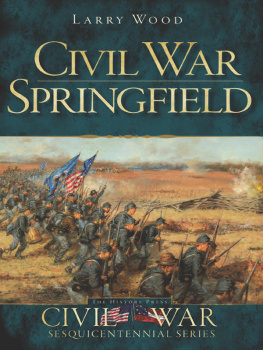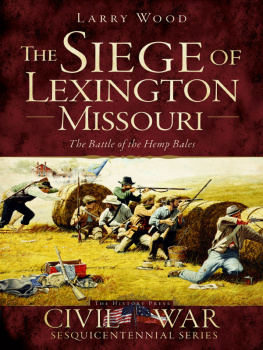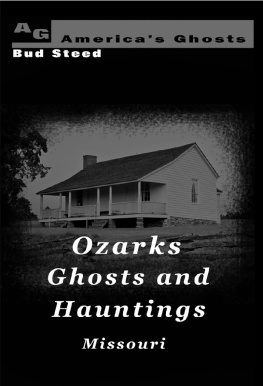Copyright 2011
By Larry Wood
All rights reserved
The word Pelican and the depiction of a pelican are trademarks of Pelican Publishing Company, Inc., and are registered in the U.S. Patent and Trademark Office.
Library of Congress Cataloging-in-Publication Data
Wood, Larry (Larry E.)
Desperadoes of the Ozarks / Larry Wood.
p. cm.
Includes bibliographical references and index.
ISBN 978-1-58980-962-8 (pbk. : alk. paper);
9781455619788(ebook) 1. Ozark
MountainsHistoryAnecdotes. 2. OutlawsOzark
MountainsBiographyAnecdotes. 3. CriminalsOzark
MountainsBiographyAnecdotes. 4. CrimeOzark
MountainsHistoryAnecdotes. 5. Ozark Mountains
BiographyAnecdotes. 6. Ozark MountainsHistory, Local
Anecdotes. I. Title.
F417.O9W659 2011
976.71--dc23
2011034315
Printed in the United States of America
Published by Pelican Publishing Company, Inc.
1000 Burmaster Street, Gretna, Louisiana 70053
Contents
Preface
My previous book on the subject of outlawry in the Ozarks, Ozarks Gunfights and Other Notorious Incidents, chronicled twenty-five events that occurred in the region between the close of the Civil War and the middle of the twentieth century. The current work tells the stories of an additional twenty-two. In only one case does a subject appear in both books. The first volume told the story of Bonnie and Clydes shootout with Joplin, Missouri, police in April of 1933, while this one devotes a chapter to the desperate duos other notorious shenanigans in the Ozarks.
To anyone who might question whether there were forty-seven incidents and/or characters in the Ozarks from 1865 to 1950 that can rightly be described as notorious, let me just say that I have picked only the most infamousthe ones that have a sensational or at least an unusual element to them. If a man committed a simple murder and was sentenced to life imprisonment for his crime, his story probably didnt make it into either book. However, if he killed a whole string of people, if he was lynched by a mob in retaliation for his crime, or if the crime stood out in some other fashion, I at least took a second look at the story, and it may well have made it into one of the two books. While some of the incidents and characters in this book may not be well known, these tales of true crime are intriguing, as several of them have not been previously told except in newspapers of the period. I hope you will find the stories of these desperadoes as fascinating as I have.
Acknowledgments
A number of libraries, museums, and historical groups provided photographs or information for this book, and I would like to recognize those facilities and organizations. They include the Arkansas History Commission, the Baxter Springs Heritage Museum, the Granby Mining Museum, the Historical Museum for Springfield-Greene County, the Jacksonport State Park, the Jasper County Records Center, the Joplin Public Library, the Kansas Historical Society, the Logan County Historical Museum, the Neosho-Newton County Library, the Pleasant Hill Historical Society, the Springfield-Greene County Library, the State Historical Society of Missouri-Columbia, and the Texas County Historical Society.
I also want to thank certain individuals, some associated with the organizations listed above and some not, who helped me with the book in one way or another. They include Phyllis Abbott, Mark Ballard, Jesse Bellard, Linda Childers, Patty Crane, Dixie Haase, Jim Hounschell, Angela Jackson, Bob Kennedy, Lisa Keys, Scott Mallatt, Larry ONeal, Jeanne Reynolds, Kathy Richardson, R. J. Savage, Earleene Spaulding, Jason Sullivan, and Steve Weldon.
I also want to thank Pelican editor Nina Kooij for her excellent edit of the manuscript. I know the final product is better because of her input.
As is normally the case with my writing, my wife, Gigi, served as the first reader of many of these stories, and I thank her not only for her proofreading skills but also for her continued support and encouragement.

1
A Horrible and Fiendish Murder and a Swift and Merited Vengeance
Twenty-year-old Jackson Carney must have been surprised when his wayward cousin, twenty-six-year-old George Moore, showed up one morning at the store Jackson ran with his nineteen-year-old bride of ten months, Cordelia. It was around eleven on Saturday, December 4, 1869, in Shell Knob, Missouri, just west of the Barry-Stone county line. About a year earlier, Jacksons father, John, had sent Moore to escort an old man home from the Carney place north of Shell Knob after the man became too intoxicated to be trusted with his team of horses. But instead of seeing to the mans safety, Moore used the opportunity to rob him of ten dollars and then fled to Arkansas.
Around the first of December, though, Moore had reappeared in Barry County at Gadfly (present-day Corsicana), west of Purdy, and now he was back at Shell Knob. According to the Springfield Missouri Patriot, he exhibited a great deal of pleasure at seeing his cousin and made himself very familiar with him. In fact, he was more familiar than seemed agreeable to Carney, but what was the young storekeeper to do?
After all, George Moore wasnt just a cousin to Jackson Carney; he was more like a brother. Moore had grown up in the Carney home after his own parents died of smallpox when he was a young child. Therefore, despite any misgivings he might have had about his errant cousins sudden reappearance, Carney treated Moore with the considerations due to an old friend. He even scuffled goodnaturedly with the visitor when Moore kept pressing him to do so.
Moore hung around the store throughout the day with every appearance of friendship between the two young men, but scarcely had the sun gone down, according to the Springfield newspaper, and the last of the days visitors left the store, when Moore threw off his disguise, and enacted the bloody and heartless crime for which he had apparently come. With darkness approaching, Moore shot Jackson Carney once in the mouth and once in the throat. Then he fired a bullet into the young womans head from such close range that a portion of her clothes caught fire from the blast and burned almost to her waist.
After the murders, Moore promptly struck out about nine miles toward Cassville and spent the night at the home of a man named Lewis Woodridge. On Sunday, the murderer attended church services at the Horner schoolhouse, southeast of Cassville.
Meanwhile, the bodies of his victims were not discovered until about four oclock on Sunday afternoon, when a customer stopped at the store to pick up some goods he had purchased the day before. Upon entering the unlocked building, the customer found Carney lying on his back in the storeroom. Cordelia was lying about twenty feet away near the living quarters of the double-log structure.














